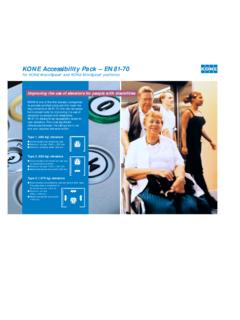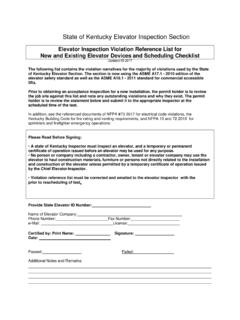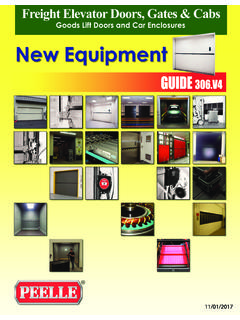Transcription of Reference Standard 18 REFERENCE STANDARD RS-18 …
1 REFERENCE STANDARD 18343 REFERENCE STANDARD RS-18 ELEVATORS AND CONVEYORS*LIST OF REFERENCED NATIONAL STANDARDSANSI/ASME Code for Elevators and Escalators and Supplements as 1996 ANSI National STANDARD for Buildings and Facilities Providing Accessibility andUsability for Physically Handicapped People as 1986 ANSI Requirements for the Construction, Care and Use of Automobile 1981FS00-L-360D Motor Vehicle 1987 ANSI/ASME Dock Levelers and 1987]ANSI/ASME standards for Conveyors and Related 1987 ANSI Requirements for Personal 1981 ANSI/ASME STANDARD for Belt 1985 ANSI Requirements for Aerial Passenger Tramways and Supplements F698 STANDARD Specification for Physical Information to be Provided for Amusement Rides andDevices as **ASNT/SNT-TC-1 AAmerican Society for Nondestructive Testing Certification/ Qualification RecommendedPractice in 1992**ASTM for Non-destructive Testing.
2 1995**ASTM F770 Practice for Operation Procedures for Amusement Rides and **ASTM F846 Guide for Testing Performance of Amusement Rides and Devices .. 1992**ASTM F853 Practice for Maintenance Procedures for Amusement and *DOB 1-16-03; 5-22-95; 11-91 BCR; 678-85 BCR; 98-83 BCR **DOB 3-8-96 REFERENCE STANDARD RS 18-1 ANSI/ASME Safety Code for Elevators andEscalators and Supplement as in such Code REFERENCE is made to the NationalElectrical Code ANSI/NFPA NO. 70, substitute New YorkCity Electrical code, Rules and Regulations of the Bureau ofElectrical Control of the Department of Buildings and itsAdvisory BoardWherever in such Code REFERENCE is made to the localBuilding Code, or model building code, substitute New YorkCity Building in such Code REFERENCE is made to ASME ,Safety Code for Existing Elevators and Escalators, substituteArticle 2 of Subchapter 18 of such The provisions of ANSI/ASME Supplement shall be subject to the followingmodifications.
3 The section numbers are from that STANDARD . 1. Add or amend the following definitions toIntroduction-Section 3 - Definitions:(i)Amend the definition designated level to read as follows:Designated [main] street floor or other level thatbest serves the needs of emergency personnel for fire fightingor rescue purposes (applicable to Rule ).(ii) Add the definition elevator classification betweenelevator and freight elevator to read as follows: elevator elevator is classified as freight orpassenger.(iii) Add the definition elevator , service car between elevator ,rooftop and elevator , shipboard to read as follows: elevator , Service A passenger or freight elevatorlocated in an Interim Multiple Dwelling registered with theLoft Board, in accordance with Article 7-C of the MultipleDwelling Law.(iv) Add the definition hospital emergency service betweenhoistway gate and hydraulic elevator to read as follows:Hospital Emergency A special operating controlfunction that may be provided for elevators in a buildingclassified in occupancy group H-2 (Hospital) or otherapplicable medical facility used to transport patient ina life or death situation.
4 (v) Amend subdivisions a and b of the definition installationplaced out of service to read as follows:Installation placed out of An installationwhose power feed lines have been disconnected fromthe mainline disconnect switch and;(a) an electric elevator , dumbwaiter, sidewalk elevator ormaterial lift whose suspension ropes have been removed,whose car and counterweight rest at the bottom of thehoistway, and whose hoistway doors have been permanentlybarricaded or sealed in the closed position on the hoistwayside;(b) a hydraulic elevator , dumbwaiter, sidewalk elevator ormaterial lift whose car rests at the bottom of the hoistway;whose pressure piping has been disassembled and a sectionremoved from the premises; whose hoistway doors havebeen permanently barricaded or sealed in the closed positionon the hoistway side; suspension ropes removed andReference STANDARD 18344counterweights, if provided, landed at the bottom of the hoistway(c) an escalator or moving walk whose entrances havebeen permanently barricaded.
5 (vi) Add the definition patient elevator between passengerelevator and penetrate a floor to read as follows:Patient An elevator located in a buildingclassified in occupancy group H-2 (hospital) reserved for the sole use of vertical transportation of non-ambulatorypatients who are incapable of self-preservation because ofage, physical or mental disability. Hospital staff or otherpassengers transporting patient are permitted to ride with thepatient. Such elevators must be operated by a designatedattendant and shall meet the requirements of rules (c) of this REFERENCE STANDARD .(vii) Add the definition platform guard (toe guard or apron)between pit elevator and plunger (ram) to read as follows:Platform Guard (Toe Guard or Apron).- A section ofsheet metal the full width of the door opening, securelyattached to the car sill and extending downward, protectingthe landing zone.
6 (viii) Delete the definition of private residence and substitutethe following:Private A building in occupancy group J-3except group home as defined in Section 27-266 of articleeleven of subchapter three of this chapter.(ix) Add the definition sky lobby between skirt, escalatorand slack-rope switch to read as follows:Sky The lowest landing of an elevator or a groupof elevators located above the street level. (x) Add the definition smoke hole between slope, moving walkand solid state device to read as follows:Smoke An opening for an elevator hoistway ventingin the elevator machine room floor at the top of the elevatorhoistway(s).(xi) Add the definition zero clearance vestibule after yieldstrength to read as follows:Zero Clearance A space on the elevator lobbybetween the exterior of hoistway door and the security doorattached to the elevator hoistway.
7 2 Delete and replace subdivision d of rule to read Multiple Hoistways.(1) Not more than three (3) elevators shall be located inbuildings with a single hoistway.(2) Not more than four (4) elevators shall be located ina single hoistway in buildings with more than one (1)hoistway.(3) Low rise, mid rise and high rise elevators shall be locatedin separate hoistways. 3 Amend sub division d of rule to read as follows: Construction of Floors [may] shall beeither of concrete, or [may be] of metal construction [withor] without perforations. [Metal floors shall conform to thefollowing:(1) If of bar-type grating, the openings between bars shallreject a ball in. (19mm) in diameter.(2) If of perforated sheet metal or of fabricated openworkconstruction, the openings shall reject a ball 1in. (25mm) indiameter.]
8 ] 4. Delete and replace rule to read as follows:Rule Control of Smoke and Hot of elevators shall be provided with means toprevent the accumulation of smoke and hot gases in case offire by any one of the following: Vents in the hoistway enclosures.(1) Location of Vents: (a) In the side of the hoistway enclosure below the elevatormachine room floor or in the roof of the hoistway, andshall be open either directly to the outer air or through non-combustible ducts to the outer air. (b) In the wall or roof of an overhead elevator machineroom through the smoke hole in the top of the elevatorhoistway and shall be vented to the outer air through non-combustible ducts.(2) Area of The area of vents in hoistway orelevator machine room and area of smoke hole shall be notless than three and one-half (3 ) percent of the area of thehoistway nor less than three (3) square feet for each elevatorcar, whichever is greater, with the following vent types:(a) Open of the total required vent area, notless than one-third (1/3) shall be permanently open or withopenable hinged damper.
9 Smoke hole shall be permanentlyopen.(b) Closed The two-third (2/3) closed portion ofthe required vent area either in the hoistway enclosure or inthe elevator machine room may consist of windows orskylights glazed with plain glass not more than one-eighth(1/8) inch thick. A closed damper that will open upon theactivation of a smoke detector placed at the top of thehoistway shall be considered closed Mechanical ventilation of the In all elevator and dumbwaiter hoistways wherethe venting of elevator and dumbwaiter hoistway is bymechanical means, there shall be provided a system of amechanical ventilation of sufficient capacity to exhaust atleast twelve (12) air changes per hour of the volume ofsuch hoistways through a roof or an approved location onan exterior wall other than the lot line wall, and shall besubject to the following: (1) The smoke detector shall be placed at the top ofthese hoistways to activate mechanical ventilation system.
10 (2) A mechanical ventilation system serving thesehoistways shall not pass through the overnight sleepingareas of hotel, apartment house, hospital, or similarbuilding. (3) A manual control to shut down the mechanicalventilation system shall be provided in or near the elevatorcontrol panel at the designated level. Air pressurization of hoistway air pressurization of the hoistway is utilized as ameans of smoke and hot gas control, the air shall not beintroduced into the hoistway in such a manner as to causeerratic operation by impingement on landing or cardoor equipment, traveling cables, selector tapes, governorReference STANDARD 18345ropes, compensating ropes, and other components sensitiveto excess movement or deflection. The Commissioner may accept alternate meansto prevent the accumulation of smoke and hot gases in thehoistways of elevators in case of fire.
















